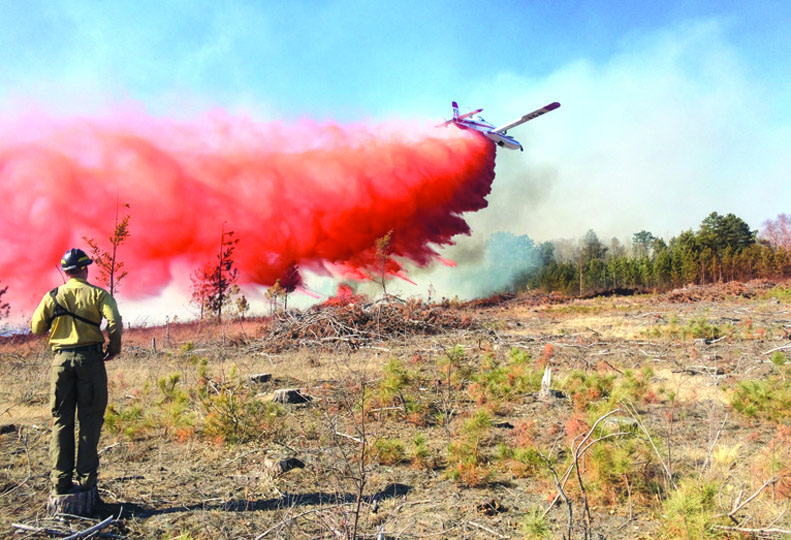
Home » Firefighting company to add planes in Deer Park
Firefighting company to add planes in Deer Park
Aero Spray reports record year with busy fire season

July 30, 2015
Aero Spray Inc., an Appleton, Minn.-based aerial firefighting service with a base in Deer Park, says it could expand its operation here during what’s been an unusually busy fire season.
“This year’s fire season has been a record for the company, the busiest the fleet has ever been,” said Jamie Sargent, Aero Spray’s business development consultant. “Our business has been driven by an early start to fire season in Minnesota, an active fire season in Alaska, and Washington’s continuing drought.”
The number of aircraft at the Deer Park location could potentially increase to five, once three more AT-802F “Fire Boss” models, made by Texas-based Air Tractor Inc., return from firefighting efforts in Alaska.
“We started in Deer Park on a trial basis back in 2008,” Sargent says. “From there, we were awarded an exclusive contract with the Bureau of Indian Affairs which we renewed in 2014. We were fortunate to find local resources who had experience in the piloting and maintenance of these planes.”
Company owner John Schwenk made his start as an apprentice agricultural pilot under the tutelage of his father, Philip Schwenk, in their family-run aerial spraying business. By 1988, John had started his own company, which in the 1990s was incorporated as Aero Spray. The company expanded its services to include firefighting in 1996.
Aero Spray currently has 10 airplanes, including two agricultural Air Tractor AT-802 models, two AT-502 models, and six AT-802F models, which service several states during various regional fire seasons. These planes are used for exclusive contracts with Minnesota and Idaho, as well as federal agencies such as the U.S. Department of Interior’s Bureau of Indian Affairs, and the Bureau of Land Management. They also have call-when-needed contracts with state agencies in Washington, Oregon, and California.
“We’ve grown quite a lot since 2009. Back then, we only had one AT-802F and two-wheeled airplanes, short contracts and call-when-needed agreements,” Sargent says. “Since that time we’ve added eight airplanes. Most are Fire Bosses, because they’re beginning to be recognized for their effectiveness at fighting fires in areas with water sources close to fire events.”
The company’s firefighting planes usually begin operation with Minnesota’s fire season in the early spring, continue on into Alaska, move to the Pacific Northwest by summer and continue farther south into California from September through December. There is also the potential for planes to travel to southeastern states like Florida, Georgia, and North Carolina as early in the year as February.
“We try to stitch as many firefighting contracts together as we can, with a goal or keeping our workers out in the field for at least 10 months a year,” Sargent says.
The number of employees varies depending on contracts awarded and the density of each fire season, he says. However, the company is usually able to employ around 30 people. This includes pilots, ground support, maintenance, and administrative employees.
Usually the company’s contracts last 60 days, with an availability fee to keep the planes ready for action around the clock. The company is also paid a daily fee to keep equipment and staff ready and an hourly fee for aircraft operations to cover fuel, pilots and insurance costs.
The base at Deer Park currently employs eight people, including two pilots and two loaders per aircraft, as well as maintenance workers, and houses two company Fire Boss planes. One is under contract with the BIA and the other is part of a cooperative supply arrangement between Minnesota’s Department of Natural Resources and Washington state.
The planes stationed at the Deer Park base mostly cover the state of Washington, although they have been loaned out to Idaho, Montana and Oregon.
Their general area includes Deer Park, Spokane and surrounding homes or business. Planes are usually dispatched near water sources that are suitable scooping sites, such as the Columbia River.
The Fire Boss is amphibious, having the ability to work as a land-based aircraft or a scooper. According to Aero Spray’s website, those planes are able to scoop up to 820 gallons of water in 30 seconds and return to the site of a fire right away. This gives the Fire Boss an advantage in fighting fires close to water sources, as it can continue to scoop and drop water for three to four hours straight.
While the Aero Spray’s revenue is private, Sargent estimates that the Fire Boss is a $3 million plane with an hourly operating cost of $1,500.
“Overall these are very cost-effective planes, able to conduct rapid initial attacks on fires and keep them from spreading. They’re a very flexible tool,” he asserts.
It is expected business will only continue to grow, Sargent says, as the Fire Boss is recognized by more agencies for its potential in firefighting techniques.
Latest News
Related Articles




